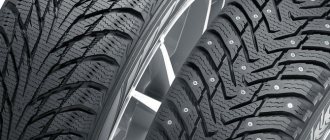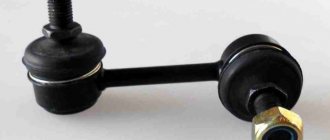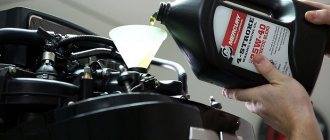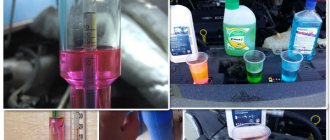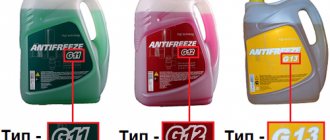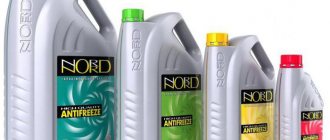03.03.2022 6 604 Coolant
Author: Victor
The performance of antifreeze used in a car engine determines the operation of the cooling system as a whole. Therefore, it is important to know about the service life of this consumable. What is the shelf life of antifreeze before and after opening the package and how to properly store the liquid, you can find out from this material.
[Hide]
Types of antifreeze
The duration of storage and operation depends on the product manufacturer, as well as the type of consumables. The color of the liquid, be it red, blue or green, plays a minor role in this matter.
There are two main types of antifreeze:
- Silicate. This type of liquid includes the domestic “Tosol”. The consumables contain borates, phosphates, silicates, nitrates and other salts of inorganic acids. The main element is silicates, which are included in the additive set. They have serious disadvantages that negatively affect the functioning of the engine cooling system as a whole. During operation, deposits remain on internal components. At least they protect the cooling system from rust, since ethylene glycol is an aggressive component towards metals. However, these same elements are characterized by reduced thermal conductivity, as a result of which they contribute to the deterioration of heat transfer. And if there are problems with the operation of the power unit, this can lead to its rapid overheating and accelerated wear. Also, additives made on the basis of silicates are depleted after 30 thousand kilometers. They begin to lose their anti-corrosion characteristics and contribute to the development of corrosion.
- Carboxylate. Such liquids are produced on the basis of organic acids. Compared to silicate ones, they do not have many disadvantages. Carboxylate antifreezes can operate over a wider temperature range. During operation, they do not lose their performance characteristics and create a protective film only in those places where there are pockets of corrosion, preventing rust from spreading further throughout the system. The heat exchange of the motor is not disturbed. Carboxylate consumables are more stable. They do not form sediment in the radiator, expansion tank and cooling system pipes, and do not become a gel over time. Moreover, the composition of such substances depletes a little more slowly. This is due to the fact that the service life of such refrigerants based on organic components is more than 200 thousand km.
In addition to these two varieties, car coolants are divided into classes:
- G11. This refrigerant is considered one of the cheapest. It is produced on the basis of ethylene glycol, and the product contains a minimal package of additives. Silicate additives protect the internal combustion engine cooling system from corrosion. Such fluids are usually used in Russian-made cars. The average service life is about two years.
- G12. The composition of such products does not contain nitrites. The consumable material is based on ethylene glycol, only higher quality and cleaner from an environmental point of view. The product base also consists of carboxylate compounds. When corrosion occurs in the cooling system, the coolant quickly localizes the affected areas. According to reviews, this refrigerant has proven itself well when used in high-speed engines that generate elevated temperatures during operation.
- G12+. Produced on the basis of polypropylene glycol. This substance belongs to the class of non-toxic and quickly decomposing. Polypropylene glycol is considered the safest refrigerant from an environmental point of view. Thanks to a carefully selected base and a set of additives, the use of such antifreezes is allowed in power units made using aluminum and cast iron. The cost of a product belonging to this class is higher, but this is due to the good quality of the liquid.
- G12++. This refrigerant is considered a hybrid version of a carboxylate as well as a silicate liquid; it is a universal liquid. The product contains no borates or phosphates. G12++ refrigerants are compatible with older types of antifreeze. The consumable material effectively protects the cooling system of machines with increased circulation speed, as well as high thermal load on the motor.
- G13. Also refers to the hybrid type. This liquid has similar properties and characteristics to G12++ standard products. The difference is that its composition is more advanced. But there are no other fundamental differences between them.
Composition and characteristics
The shelf life of antifreeze largely depends on the composition of the liquid:
- Ethylene glycol. Monoethylene glycol, ethanediol and other base components can be used. It is a diatomic alcohol characterized by an oily consistency. The liquid has almost no odor and is viscous to the touch. The density parameter of the base product averages about 1.112-1.113 g/cm3, provided that it is measured at a temperature of 20 degrees Celsius. The temperature at which liquid boils varies around 196 degrees, and it freezes at -12. Therefore, this concentrate is always diluted with distilled water. When the refrigerant heats up, it begins to expand. Accordingly, approximately 10% less of it must be poured into the cooling system.
- Distilled water. Its use is mandatory since a pure base freezes at slightly sub-zero temperatures. The distillate must be used. If you mix the concentrate with tap water, scale will form on the inner walls of the cooling system hoses, as well as in the radiator unit.
- Additive package. All modern refrigerants use anti-corrosion additives designed to protect the cooling system from rust. Such additives are divided into several types - carboxylate, traditional, lobrid and hybrid. The first ones are made on the basis of organic compounds, the second ones - using inorganic ones and are considered the oldest. They were also used in Antifreeze, which was produced under the USSR. Hybrid ones are produced using organic and inorganic compounds, and lobrid ones are considered the most advanced to date. Additives can be anti-foam additives designed to prevent foam from appearing in the cooling system.
Table of corrosive effects of refrigerant composition on metals
Does he exist?
Antifreeze still has an expiration date and it must be indicated by the manufacturer on the packaging (as well as the production date).
On average it is 3-5 years .
This is due to the fact that antifreeze contains various types of additives necessary to increase the heat transfer coefficient (to remove heat from the engine), as well as to prevent metal corrosion and the formation of limestone deposits in the radiator and pipes.
And these same compounds can oxidize or precipitate over time.
But even after 5-10 years of storage, antifreeze retains its basic properties - good heat dissipation (higher than water) and a low freezing point. However, its water content may increase.
, only 75% distilled water is allowed in antifreeze . And even if during production the initial concentration was within 30-40%, then over time it can increase (especially if storage is in a garage, in a poorly insulated container) up to 80%.
Naturally, both the freezing temperature and the heat transfer coefficient of antifreeze will decrease.
Find out about the shelf life of winter, summer and truck tires according to GOST from our article.
GOST standards
All features and characteristics for coolants are described in detail in the regulatory document GOST 28084-89. In accordance with this, since 1992, the shelf life of consumables intended for use in machine engines must be at least five years. Before this, the period was three years. But not all manufacturers adhere to this GOST, especially when it comes to foreign companies. The composition of foreign-made liquids is practically uncontrolled. Therefore, you may find products on sale that do not comply with GOST standards.
Shelf life before and after opening the package
Manufacturers of consumables usually do not indicate that the storage life before and after opening the bottle will be different according to certain parameters. There is one permissible period of five years according to GOST. In fact, consumables, hermetically sealed in packaging, can have a shelf life of more than 5 years. During this time, the liquid will not be able to change its operational properties and features. There should be no sediment at the bottom of the canister, and the ratio of the base substance and distilled water will be at the same level.
A hydrometer can be used to diagnose the ratio of distillate to base. If the density is compromised for some reason, this will lead to a loss of technical properties of the product. After opening the bottle, the storage life of the substance will be lower. This occurs as a result of the additives coming into contact with oxygen, which causes the base to evaporate. The condensate will replace the base, resulting in an increase in the percentage of distillate.
The Cars and Spare Parts channel made a video on how to properly change antifreeze.
How and where should it be stored?
In accordance with technical regulations, manufacturers of consumables advise storing coolant exclusively in the original packaging. This could be a canister or a plastic bottle. The refrigerant storage temperature should be up to 15 degrees Celsius. The main condition is to prevent sunlight from entering the canister, since ultraviolet radiation negatively affects the technical properties of the consumable material.
In addition, the consumer must maintain the integrity of the packaging. If the canister is open, then the neck itself should be covered with a seal, after which the cap must be completely screwed in to prevent air or moisture from getting inside. If the original packaging is damaged, it can be replaced with another, but it is important that it is made of polyvinyl chloride. This material belongs to food grade plastic, while PVC does not react with oily components. During the cold season, refrigerant cannot be stored in the garage at low temperatures. The product can be stored indoors at a temperature of at least 2 degrees.
What happens to Antifreeze over time?
If the refrigerant is stored for a long time, its alkalinity begins to drop. There is an increased likelihood of foam formation when using liquid. The color of the consumable becomes darker, and in some cases sediment may form on the bottom. In addition, the density parameter is also reduced, which can be reduced to 0.9. When storing a product in an unsealed container or at critically low or elevated temperatures, these processes begin to accelerate. As a result, the liquid will lose its technical characteristics.
You can learn about the timing of replacing the coolant from the video filmed by the Pro Auto32 channel.
General provisions
6.1.1. The technical condition, equipment and completeness of vehicles of all types, brands, purposes, trailers and semi-trailers in operation must comply with the requirements of current regulations.
6.1.2. The following requirements are imposed on the vehicle cabin (interior):
side windows must move smoothly using window lifting mechanisms;
Dips, torn places, protruding springs and sharp corners are not allowed on the seat and backrest;
noise, vibration, microclimate and concentration of harmful substances in the cabin of a truck, inside the cabin and cabin of a bus and the body of a passenger car must comply with the values specified in current state standards, sanitary norms and rules, hygienic standards;
heating devices of the cabin and interior must be operational in cold weather; It is prohibited to use exhaust gases as a coolant to heat the cabin and interior; they can only be used to heat the coolant;
The floor of the cabin, interior and body of the vehicle must be covered with a mat that does not have holes or other damage.
6.1.3. Vehicle controls must have proper seals that prevent exhaust gases from entering the cabin or passenger compartment of the vehicle (bus).
6.1.4. Wheel discs must be securely attached to the hubs. The locking rings of the wheel rims must be in good condition and correctly installed in their places. Cracks and bent wheel rims are prohibited.
6.1.5. The technical condition of the electrical equipment of the vehicle must ensure starting the engine using a starter, uninterrupted and timely ignition of the mixture in the engine cylinders, trouble-free operation of lighting, alarm and electrical control devices, and also exclude the possibility of sparking in wires and clamps. All electrical equipment wires must have reliable, undamaged insulation. The battery must be clean and securely secured. It is prohibited to leak electrolyte from the battery monoblock.
6.1.6. Each vehicle must be provided with special stops (at least two pieces) for placing under the wheels, a wide lining under the heel of the jack, as well as a first aid kit, a warning triangle or a flashing red light and a fire extinguisher.
6.1.7. Buses and trucks adapted for the transport of people and specially equipped for these purposes must be equipped with an additional second fire extinguisher, with one fire extinguisher located in the driver's cabin, the second in the passenger compartment of the bus or the body of the car in accordance with the requirements of current regulations.
6.1.8. When sent on a long journey (lasting more than 1 day), trucks and buses must be additionally equipped with metal trestles, a shovel, a towing device, a safety fork for the wheel lock ring, and in winter - additionally with snow chains.
6.1.9. The crankshaft ratchet should be unslotted and the crank handle should have a straight stud of appropriate length and strength. The handle of the starting handle should be smooth and free of burrs.
6.1.10. The exhaust pipes and muffler must not have cracks or punctures, and their connections must not allow exhaust gases to pass through. The end of the exhaust pipe must not be dented or damaged.
Vehicles operating during harvesting must have exhaust pipes equipped with spark arresters.
6.1.11. Vehicles with lift-up cabs must have working latches on the cab stops.
6.1.12. Cabin doors and hoods must have working opening limiters and open and closed position locks.
Permissible operation period
Car manufacturers advise changing the coolant at least once every three years or after a mileage of 60 thousand km. But during operation, the car owner must periodically monitor the condition of the consumables. For visual inspection, open the lid of the container in the engine compartment and evaluate the liquid. Diagnostics should be performed with the engine turned off and cold. When the refrigerant is a darker shade than its original color and contains traces of scale or deposits, it means it needs to be replaced.
It is recommended to take into account the temperature parameters of the power unit. If, for unknown reasons, the engine temperature begins to increase arbitrarily even by five degrees, this indicates a malfunction in the cooling system. And diagnostics begins with consumables. When using refrigerant with an old expiration date, normal operation of the motor is possible, but its temperature will increase to a critical level. Due to the loss of properties by additives and the susceptibility of metal elements of the cooling system to corrosion, additives will not be able to protect them.
Coolant composition
The exact composition of coolants is kept strictly confidential by manufacturers, since this information is a trade secret.
The main components are the following:
- propylene glycol or ethylene glycol (base);
- water;
- additive complex;
- dye (needed solely to prevent someone from accidentally drinking the coolant - it is extremely poisonous).
Antifreeze: red, green, blue. What is the difference ? Just about the difficult stuff in this video:
What determines the shelf life of a car battery? Read about it here.
Substitution rules
When replacing consumables, adhere to the following rules:
- When changing the fluid, be sure to flush the cooling system. To do this, you can use special products that are poured into the expansion tank. When using such substances in a car, you should drive from 20 to 200 km, depending on the recommendations indicated on the packaging. Rinsing can be done with distilled water, Coca-Cola, water with the addition of vinegar or citric acid.
- When filling, do not use concentrated liquid. It is better to dilute such a refrigerant with distillate; the proportions for this are indicated on the packaging.
- After filling the refrigerant, do not add water to the cooling system. Mixing with other brands of antifreeze, especially those of different standards, is not recommended. If it is necessary to add, it is important to ensure that the compositions of the substances match.
- If the refrigerant is not recommended for your vehicle, it is best to avoid using it.
What to do if you fill it with antifreeze that has expired?
1. Open the plug and drain the refrigerant from the system
2. Pour flushing agent into the system
3. Remove deposits from the pipes or replace them
4. Fill with new antifreeze
Using old coolant will cause deposits, sludge and scale to form in the radiator of the cooling system. If you have filled in antifreeze that has expired, you must flush it.
The cleaning procedure is performed as follows:
- First, the old refrigerant is drained from the cooling system. To do this, place a bucket or cut-off bottle under the drain hole, then unscrew the cap. The draining procedure is performed on a cold engine.
- Wait until all the refrigerant has drained.
- Tighten the plug. Fill the expansion tank under the hood with distilled water. Its volume must correspond to the amount of refrigerant drained.
- Start the engine. Let the engine run for about 15-25 minutes in idle mode. You can perform a test drive by increasing the unit speed.
- Stop the engine and drain the distillate from the system. If it is too dirty and there are traces of scale in it, wash it again. The cleaning process is carried out until clean water begins to leave the system.
- Then new refrigerant is added. After filling, start the engine and accelerate while squeezing the rubber hoses of the cooling system. This will avoid air pockets. Perform a test drive and add antifreeze to the system level.
Can I use an expired product?
Using antifreeze after its expiration date is strictly prohibited.
This is due to the fact that old coolant entering the system causes scale to form on the radiator.
This is due to the occurrence of sediment processes in the material, which can adversely affect the internal surfaces of many car parts.
If antifreeze has entered the system and its expiration date has expired, it is necessary to carry out high-quality and reliable flushing of the pipes.
The efficiency of the vehicle’s internal combustion engine directly depends on the quality and reliability of antifreeze. That is why experts recommend using only proven coolant, which cannot lead to adverse consequences and problems in the operation of the car’s power unit.
Video “How to flush the cooling system?”
User Lesha Master made a video in which he clearly showed the procedure for flushing the cooling system in a Daewoo Sens car.
Do you have any questions? Specialists and readers of the AUTODVIG website will help you ask a question
Was this article helpful?
Thank you for your opinion!
The article was useful. Please share the information with your friends.
Yes (83.33%)
No (16.67%)
X
Please write what is wrong and leave recommendations on the article
Cancel reply
Rate this article: ( 13 votes, average: 4.54 out of 5)
Discuss the article:
